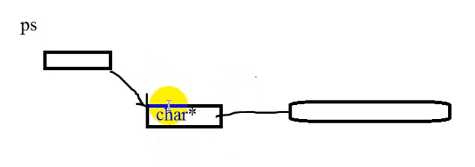构造器(constructor)
1.与类名相同,无返回,被系统生成对象时自动调用,用于初始化。
2.可以有参数,构造器的重载,有默认参数。重载和默认参数不能同时出现,但是一定要包含标配(无参数的构造器),为了对象的午无参创建。
3.如果未提供任何构造器,系统默认提供一个无参的构造器。如果提供,则不再生成默认构造器。
#ifndef STACK_H
#define
class Stack
{
public:
Stack()//构造器,
{
top = 0;
space = new char[size];
}
Stack(int size = 100)//构造器与构造器之间是重载的关系
{
top = 0;
space = new char[size];
_size = size;
}
public:
//void init();
bool isEmpty();
bool isFull();
void push(int data);
int pop();
private:
int space[1024];
int top;
int _size;
};
#endifstack.cpp:
#include<iostream>
#inlcude "stack.h"
#include<stdlib.h>
#include<string.h>
bool Stack::isEmpty()
{
return top == 0;
}
bool Stack::isFull()
{
return top == 1024;
}
void Stack::push(int data)
{
space[top++] = data;
}
int Stack::pop()
{
return space[--top];
}main.cpp
#include<iostream>
#include "stack.h"
using namespace std;
int main()
{
Stack s;
Stack s2(100);
//s.init();
for(char v = "a";!st.isFull()&& v != ‘z‘+1;v++)
{
st.push(v);
}
while(!s.isEmpty())
cout<<s.pop()<<endl;
return 0;
}析构器(destructor)"~"
1.~与类名相同,无参,无返回。
2.对象消失的时候,自动被调用,用于对象销毁是的处理工作。
3.如果未提供任何构造器,系统会自动生成一个空析构器。
#ifndef STACK_H
#define
class Stack
{
public:
Stack()//构造器,
{
top = 0;
space = new char[size];
}
Stack(int size = 100)//构造器与构造器之间是重载的关系
{
top = 0;
space = new char[size];
_size = size;
}
~Stack()
{
delete sapce;//适合于new生成的空间
}
public:
//void init();
bool isEmpty();
bool isFull();
void push(int data);
int pop();
private:
int space[1024];
int top;
int _size;
};
#endif#include<iostream>
#include "stack.h"
using namespace std;
int main()
{
Stack s;
Stack s2(100);
//s.init();
for(char v = "a";!st.isFull()&& v != ‘z‘+1;v++)
{
st.push(v);
}
while(!s.isEmpty())
cout<<s.pop()<<endl;
return 0;
}C:
struct Stu
{
char *name;
int age;
}
int main()
{
Stu *ps = (Stu*)malloc(sizeof(Stu));
ps->name = (char *)malloc(100);//给name也要申请空间
strcpy(ps->name,"xxx");
free(ps->name);//释放的时候也要从里向外释放。
free(ps);
return 0;
}C++:
class Stu
{
char *name;
int age;
public:
Stu()
{
name = new char[100];
}
~Stu()
{
delete []name;//释放构造器中new出来的空间
}
}
int main()
{
Stu *ps = new Stu;
strcpy(ps->name,"assassin");
delete ps;//释放上述new出的空间
return 0;
}
/*
Stu *p = new Stu;生成八个字节的空间,p指向8个字节,Stu的构造器生成100个字节,name指向这100个字节。delete ps,调用了析构函数,析构函数先释放100个字节的空间,再释放掉8个字节的空间。
*/自实现string类
main.cpp
#include <iostream>
#include "myString.h"
using namespace std;
int main()
{
string s; //char * _str = "";
string s2 = "assassin"; //char * str = "xxxx";
cout<<s.c_str()<<endl;
cout<<s2.c_str()<<endl;
String ss;
String sss = "intelwisd";
cout<<ss.c_str()<<endl;
cout<<sss.c_str()<<endl;
return 0;
}myString.h:
#ifndef STRING_H
#define STRING_H
class String
{
public:
String();
String(const char *s);
char * c_str();//利用此函数输出
private:
char * _str;
};
#endif // STRING_HmyString.cpp
#include<iostream>
#include "string.h"
#include "myString.h"
using namespace std;
String::String()
{
_str = new char[1];
*_str = ‘\0‘;//字符
}
String::String(const char *s)
{
int len = strlen(s);
_str = new char[len+1];
strcpy(_str,s);
}
char * String::c_str()
{
return _str;
}改进:
myString.h文件
#ifndef STRING_H
#define STRING_H
#if 0
class String
{
public:
String();
String(const char *s);
char * c_str();
private:
char * _str;
};
#endif
class String
{
public:
//String();
String(const char *s = NULL);//无参的形式包含在里面
char * c_str();
~String();
private:
char * _str;
};
#endif // STRING_HmyString.cpp文件:
#include<iostream>
#include "string.h"
#include "myString.h"
using namespace std;
#if 0
String::String()
{
_str = new char[1];
*_str = ‘\0‘;//字符
}
String::String(const char *s)
{
int len = strlen(s);
_str = new char[len+1];
strcpy(_str,s);
}
#endif
String::String(const char *s)
{
if(s == NULL)
{
_str = new char[1];
*_str = ‘\0‘;
}else{
int len = strlen(s);
_str = new char[len+1];
strcpy(_str,s);
}
}
char * String::c_str()
{
return _str;
}
String::~String()
{
delete []_str;
}main.cpp:文件
#include <iostream>
#include "myString.h"
using namespace std;
int main()
{
string s; //char * _str = "";
string s2 = "assassin"; //char * str = "xxxx";
cout<<s.c_str()<<endl;
cout<<s2.c_str()<<endl;
String ss;
String sss("intelwisd");
cout<<ss.c_str()<<endl;
cout<<sss.c_str()<<endl;
return 0;
} string *ps = new string("assassin");
delete ps;
string *ps1 = new string("assassin1");
delete ps1;
ps指向new生成一个四个字节的空间char ,char 指向一串字符。delete ps时,先释放掉内部一串字符,再释放掉char *。
